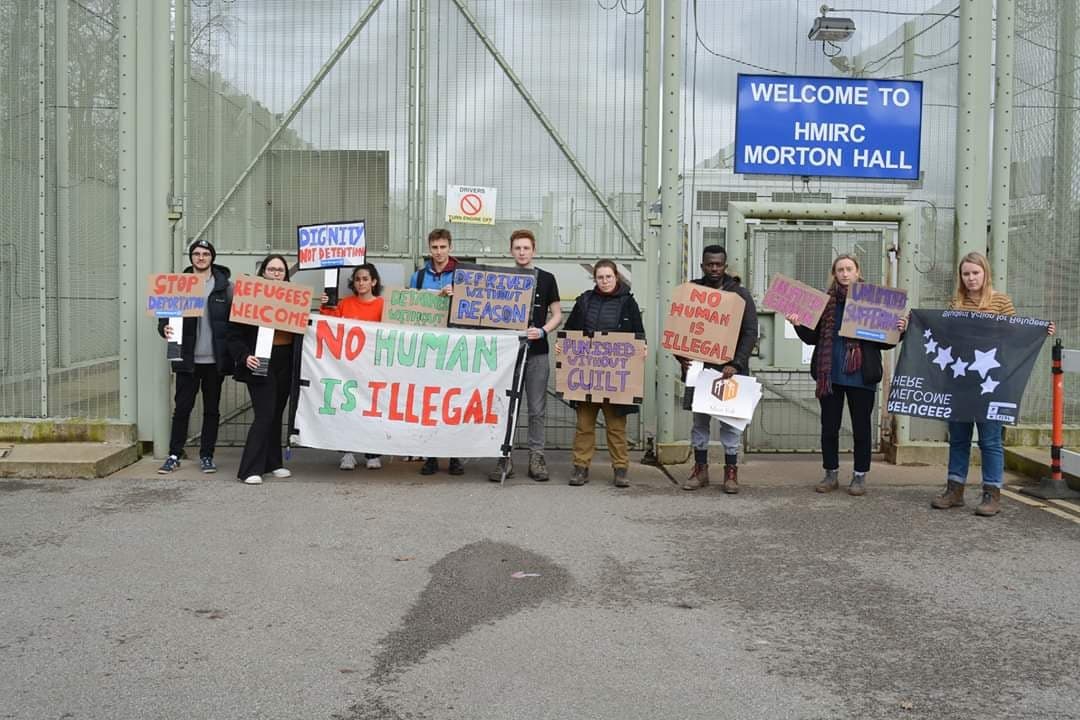Last Saturday, Leeds Student Action for Refugees campaigners convened at Morton Hall Detention Centre to protest against the facility.
Behind the grey, barbed wire topped fences are up to 392 detained people. Some of these people have fled war torn countries. Others have faced human trafficking. The government call this facility an “Immigration Removal Centre”, and just as the sanitised name might suggest, the conditions are notoriously inadequate. A detainee told the Guardian “We are all treated very badly here, like prisoners, although many of us have not committed any crime.”
Protests have been occurring at Morton Hall for 10 years. Last Saturday, the protestors attempted to make their presence known, in order to show solidarity with detainees at the centre. The protest leader, Joe Shotton, told me ‘we wanted to show publicly that detention centres are unacceptable’.
They yielded signs, one of which read “dignity not detention”, and attempted to make as much noise as possible. Despite cancellations from other protest groups due to coronavirus fears, members of Leeds Student Action for Refugees, and a person who had previously been held at a detention centre, proceeded with the protest alone.
In 2017, four people died at Morton Hall. An inquiry into the death of Carlington Spencer found that multiple failings had contributed to his death. Staff were also found to have been negligent in an inquiry into Bai Bai Ahmed Kabia’s death, in the same year. In 2019, the Home Affairs Committee reported on detention and said ‘The Home Office…has utterly failed in its responsibility to oversee the safe and humane detention of individuals in the UK’.
Detainees at the six immigration facilities across the nation are exposed to ‘high levels of self harm, violence and force’. A Channel 4 Investigation in 2015 reported a Guard at Yarl Wood Immigration Removal Centre said: “They’re animals… caged animals. Take a stick with you and beat them up”.
However, it is perhaps the mental health of the people behind the fences that is most worrying. Victor Mujakachi, from Sheffield, was released from the centre in 2019. At a Morton Hall protest last October, he said ‘there are some of my fellow detainees still there whose lives are at a standstill never knowing when they will be released.’
The UK is the only country in Europe with no time restrictions on detention. Detainees are often held for extensive duration because of documentation problems or because of a lack of suitable accommodation available.
Fifty percent of those who are detained are released, having endured often traumatic experiences in detention. The words of a refugee were read out at the October protest. She described those inside as angels that needed to be raised up and allowed to flourish, “to stop punishing strangers who run to you for help, to stop locking up future scientists and burying talent in its infancy”.
Stephanie from Lincoln, at a former protest at Morton Hall protest, said the words of Emily Dickinson came to mind: “
‘Hope is the thing with feathers’, a line that conjures flight and freedom. Her words soared over the walls of her illness… And I remembered the sound of boots banging the metal fence [at the protest] to alert the detainees inside that people were outside, making a racket on their behalf, to drown out the silence. Perhaps the boots on the fence would raise a clamour of birds above our heads, the things with feathers rising in judgement on injustice.”
Tucked away in Lincolnshire, Morton Hall is something few people know about. Even fewer have lived within its barbed wire fences. Yet the message, that ‘no human is illegal’ is a powerful one. This protest, the ones before and ones to come put these vulnerable lives and the experiences they are going through, onto the public radar.

